YAMAHA YZF-R1 2017 User Guide
Manufacturer: YAMAHA, Model Year: 2017, Model line: YZF-R1, Model: YAMAHA YZF-R1 2017Pages: 130, PDF Size: 9.99 MB
Page 11 of 130

Safety information
1-2
12
3
4
5
6
7
8
9
10
11
12
tice riding your motorcycle
where there is no traffic until you
have become thoroughly famil-
iar with the motorcycle and all of
its controls.
Many accidents have been caused
by error of the motorcycle opera-
tor. A typical error made by the op-
erator is veering wide on a turn
due to excessive speed or under-
cornering (insufficient lean angle
for the speed).
Always obey the speed limit and
never travel faster than warrant-
ed by road and traffic conditions.
Always signal before turning or changing lanes. Make sure that
other motorists can see you.
The posture of the operator and
passenger is important for proper
control.
The operator should keep bothhands on the handlebar and
both feet on the operator foot-
rests during operation to main-
tain control of the motorcycle.
The passenger should always hold onto the operator, the seat
strap or grab bar, if equipped, with both hands and keep both
feet on the passenger footrests.
Never carry a passenger unless
he or she can firmly place both
feet on the passenger footrests.
Never ride under the influence of
alcohol or other drugs.
This motorcycle is designed for
on-road use only. It is not suitable
for off-road use.
Protective Apparel
The majority of fatalities from motorcy-
cle accidents are the result of head in-
juries. The use of a safety helmet is the
single most critical factor in the preven-
tion or reduction of head injuries.
Always wear an approved helmet.
Wear a face shield or goggles.
Wind in your unprotected eyes
could contribute to an impairment
of vision that could delay seeing a
hazard.
The use of a jacket, heavy boots,
trousers, gloves, etc., is effective in
preventing or reducing abrasions
or lacerations.
Never wear loose-fitting clothes,
otherwise they could catch on the control levers, footrests, or wheels
and cause injury or an accident.
Always wear protective clothing
that covers your legs, ankles, and
feet. The engine or exhaust sys-
tem become very hot during or af-
ter operation and can cause burns.
A passenger should also observe
the above precautions.
Avoid Carbon Monoxide Poisoning
All engine exhaust contains carbon
monoxide, a deadly gas. Breathing car-
bon monoxide can cause headaches,
dizziness, drowsiness, nausea, confu-
sion, and eventually death.
Carbon Monoxide is a colorless, odor-
less, tasteless gas which may be pres-
ent even if you do not see or smell any
engine exhaust. Deadly levels of car-
bon monoxide can collect rapidly and
you can quickly be overcome and un-
able to save yourself. Also, deadly lev-
els of carbon monoxide can linger for
hours or days in enclosed or poorly
ventilated areas. If you experience any
symptoms of carbon monoxide poison-
ing, leave the area immediately, get
fresh air, and SEEK MEDICAL TREAT-
BX4-9-E0.book 2 ページ 2016年12月1日 木曜日 午後8時7分
Page 12 of 130
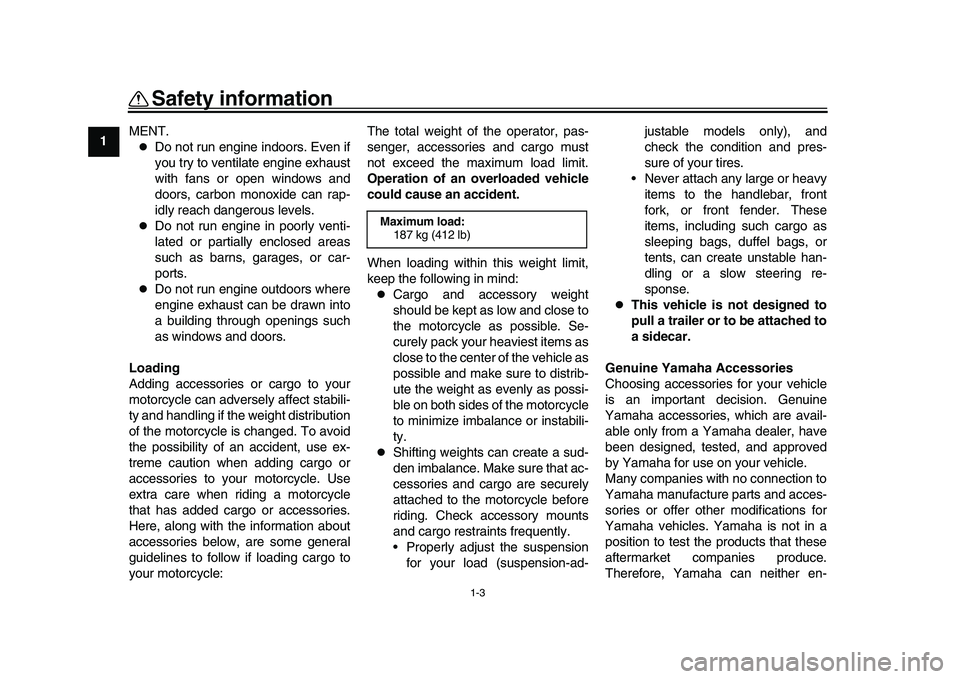
Safety information
1-3
1
2
3
4
5
6
7
8
9
10
11
12 MENT.
Do not run engine indoors. Even if
you try to ventilate engine exhaust
with fans or open windows and
doors, carbon monoxide can rap-
idly reach dangerous levels.
Do not run engine in poorly venti-
lated or partially enclosed areas
such as barns, garages, or car-
ports.
Do not run engine outdoors where
engine exhaust can be drawn into
a building through openings such
as windows and doors.
Loading
Adding accessories or cargo to your
motorcycle can adversely affect stabili-
ty and handling if the weight distribution
of the motorcycle is changed. To avoid
the possibility of an accident, use ex-
treme caution when adding cargo or
accessories to your motorcycle. Use
extra care when riding a motorcycle
that has added cargo or accessories.
Here, along with the information about
accessories below, are some general
guidelines to follow if loading cargo to
your motorcycle: The total weight of the operator, pas-
senger, accessories and cargo must
not exceed the maximum load limit.
Operation of an overloaded vehicle
could cause an accident.
When loading within this weight limit,
keep the following in mind:
Cargo and accessory weight
should be kept as low and close to
the motorcycle as possible. Se-
curely pack your heaviest items as
close to the center of the vehicle as
possible and make sure to distrib-
ute the weight as evenly as possi-
ble on both sides of the motorcycle
to minimize imbalance or instabili-
ty.
Shifting weights can create a sud-
den imbalance. Make sure that ac-
cessories and cargo are securely
attached to the motorcycle before
riding. Check accessory mounts
and cargo restraints frequently.
Properly adjust the suspension
for your load (suspension-ad- justable models only), and
check the condition and pres-
sure of your tires.
Never attach any large or heavy items to the handlebar, front
fork, or front fender. These
items, including such cargo as
sleeping bags, duffel bags, or
tents, can create unstable han-
dling or a slow steering re-
sponse.
This vehicle is not designed to
pull a trailer or to be attached to
a sidecar.
Genuine Yamaha Accessories
Choosing accessories for your vehicle
is an important decision. Genuine
Yamaha accessories, which are avail-
able only from a Yamaha dealer, have
been designed, tested, and approved
by Yamaha for use on your vehicle.
Many companies with no connection to
Yamaha manufacture parts and acces-
sories or offer other modifications for
Yamaha vehicles. Yamaha is not in a
position to test the products that these
aftermarket companies produce.
Therefore, Yamaha can neither en-
Maximum load: 187 kg (412 lb)
BX4-9-E0.book 3 ページ 2016年12月1日 木曜日 午後8時7分
Page 13 of 130
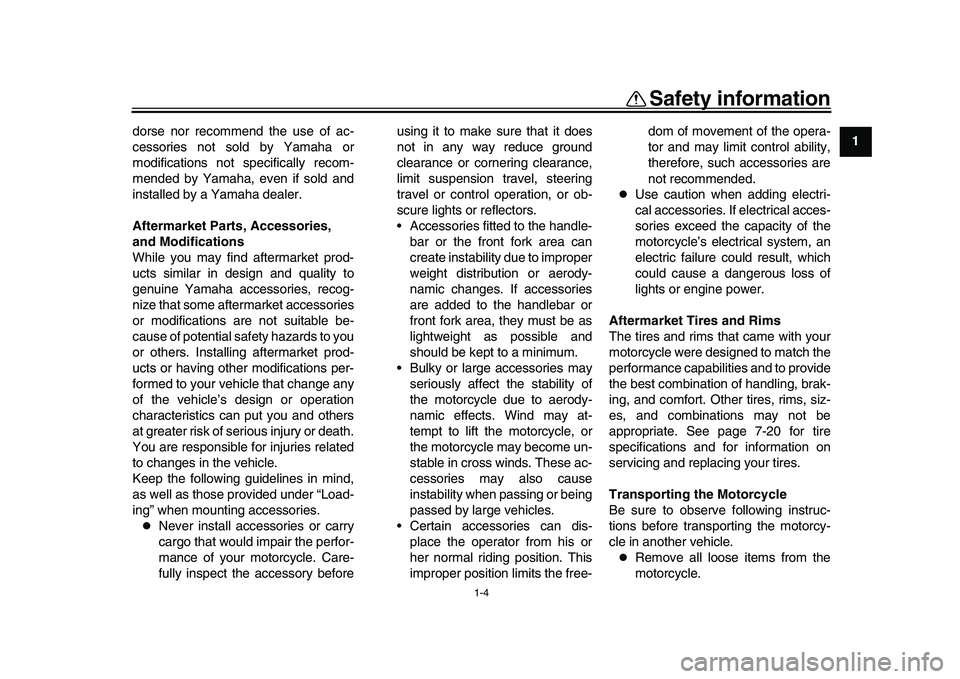
Safety information
1-4
12
3
4
5
6
7
8
9
10
11
12
dorse nor recommend the use of ac-
cessories not sold by Yamaha or
modifications not specifically recom-
mended by Yamaha, even if sold and
installed by a Yamaha dealer.
Aftermarket Parts, Accessories,
and Modifications
While you may find aftermarket prod-
ucts similar in design and quality to
genuine Yamaha accessories, recog-
nize that some aftermarket accessories
or modifications are not suitable be-
cause of potential safety hazards to you
or others. Installing aftermarket prod-
ucts or having other modifications per-
formed to your vehicle that change any
of the vehicle’s design or operation
characteristics can put you and others
at greater risk of serious injury or death.
You are responsible for injuries related
to changes in the vehicle.
Keep the following guidelines in mind,
as well as those provided under “Load-
ing” when mounting accessories.
Never install accessories or carry
cargo that would impair the perfor-
mance of your motorcycle. Care-
fully inspect the accessory before using it to make sure that it does
not in any way reduce ground
clearance or cornering clearance,
limit suspension travel, steering
travel or control operation, or ob-
scure lights or reflectors.
Accessories fitted to the handle-
bar or the front fork area can
create instability due to improper
weight distribution or aerody-
namic changes. If accessories
are added to the handlebar or
front fork area, they must be as
lightweight as possible and
should be kept to a minimum.
Bulky or large accessories may seriously affect the stability of
the motorcycle due to aerody-
namic effects. Wind may at-
tempt to lift the motorcycle, or
the motorcycle may become un-
stable in cross winds. These ac-
cessories may also cause
instability when passing or being
passed by large vehicles.
Certain accessories can dis- place the operator from his or
her normal riding position. This
improper position limits the free- dom of movement of the opera-
tor and may limit control ability,
therefore, such accessories are
not recommended.
Use caution when adding electri-
cal accessories. If electrical acces-
sories exceed the capacity of the
motorcycle’s electrical system, an
electric failure could result, which
could cause a dangerous loss of
lights or engine power.
Aftermarket Tires and Rims
The tires and rims that came with your
motorcycle were designed to match the
performance capabilities and to provide
the best combination of handling, brak-
ing, and comfort. Other tires, rims, siz-
es, and combinations may not be
appropriate. See page 7-20 for tire
specifications and for information on
servicing and replacing your tires.
Transporting the Motorcycle
Be sure to observe following instruc-
tions before transporting the motorcy-
cle in another vehicle.
Remove all loose items from the
motorcycle.
BX4-9-E0.book 4 ページ 2016年12月1日 木曜日 午後8時7分
Page 14 of 130
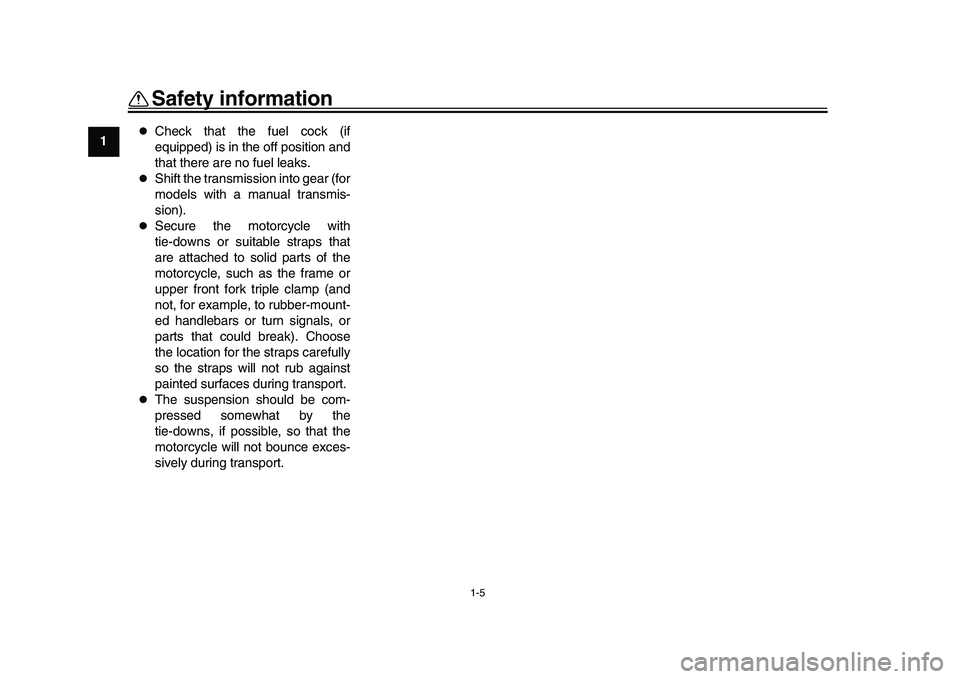
Safety information
1-5
1
2
3
4
5
6
7
8
9
10
11
12
Check that the fuel cock (if
equipped) is in the off position and
that there are no fuel leaks.
Shift the transmission into gear (for
models with a manual transmis-
sion).
Secure the motorcycle with
tie-downs or suitable straps that
are attached to solid parts of the
motorcycle, such as the frame or
upper front fork triple clamp (and
not, for example, to rubber-mount-
ed handlebars or turn signals, or
parts that could break). Choose
the location for the straps carefully
so the straps will not rub against
painted surfaces during transport.
The suspension should be com-
pressed somewhat by the
tie-downs, if possible, so that the
motorcycle will not bounce exces-
sively during transport.
BX4-9-E0.book 5 ページ 2016年12月20日 火曜日 午後5時30分
Page 15 of 130
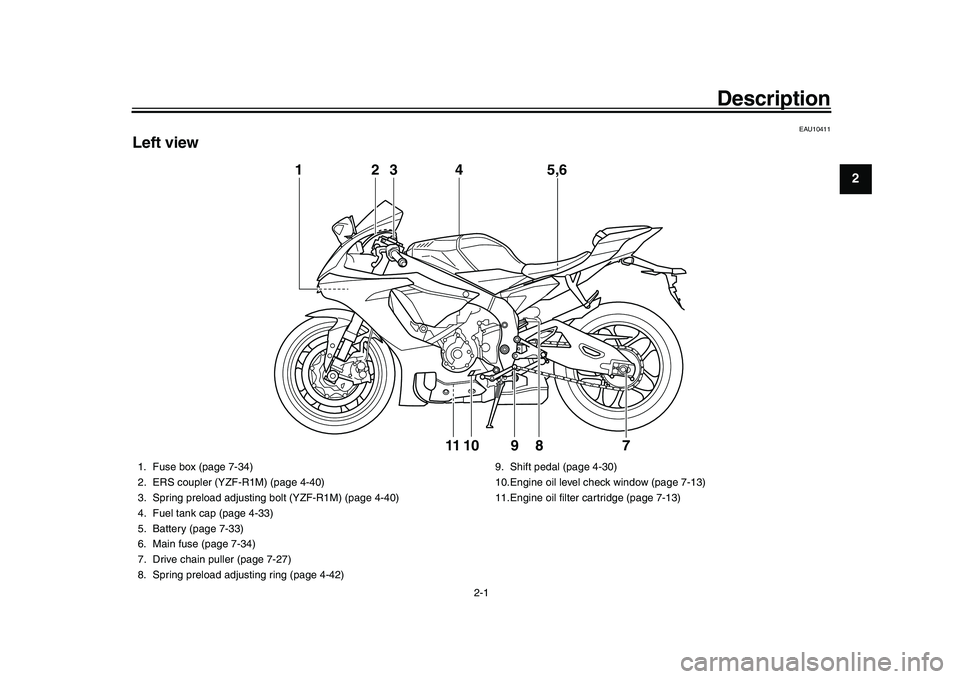
2-1
123
4
5
6
7
8
9
10
11
12
Description
EAU10411
Left view
1 3
4 5,6
10 89
2
11
7
1. Fuse box (page 7-34)
2. ERS coupler (YZF-R1M) (page 4-40)
3. Spring preload adjusting bo lt (YZF-R1M) (page 4-40)
4. Fuel tank cap (page 4-33)
5. Battery (page 7-33)
6. Main fuse (page 7-34)
7. Drive chain puller (page 7-27)
8. Spring preload adjusting ring (page 4-42) 9. Shift pedal (page 4-30)
10.Engine oil level check window (page 7-13)
11.Engine oil filter cartridge (page 7-13)
BX4-9-E0.book 1 ページ 2016年12月1日 木曜日 午後8時7分
Page 16 of 130

Description
2-2
12
3
4
5
6
7
8
9
10
11
12
EAU10421
Right view
32
4
6
7
5
1
8,9,10
1. Front brake fluid reservoir (page 7-25)
2. Document storage space (page 4-39)
3. Radiator cap (page 7-16)
4. Engine oil filler cap (page 7-13)
5. Coolant drain bolt (page 7-17)
6. Brake pedal (page 4-31)
7. Rear brake fluid reservoir (page 7-25)
8. Fast compression damping adjuster (YZF-R1) (page 4-42) 9. Slow compression damping
adjuster (YZF-R1) (page 4-42)
10.Rebound damping adjuster (YZF-R1) (page 4-42)
BX4-9-E0.book 2 ページ 2016年12月1日 木曜日 午後8時7分
Page 17 of 130

Description
2-3
123
4
5
6
7
8
9
10
11
12
EAU10431
Controls and instruments
12456 101112
3
7,8,9
1. Clutch lever (page 4-30)
2. Left handlebar switches (page 4-3)
3. ERS coupler (YZF-R1M) (page 4-40)
4. Main switch/steering lock (page 4-2)
5. Instrument panel (page 4-6, 4-9)
6. Front brake fluid reservoir (page 7-25)
7. Spring preload adjusting nut (YZF-R1) (page 4-40)
8. Rebound damping force adjusting bolt (YZF-R1)(page 4-40) 9. Compression damping force adjus
ting bolt (YZF-R1) (page 4-40)
10.Right handlebar switches (page 4-3)
11.Throttle grip (page 7-19)
12.Brake lever (page 4-31)
BX4-9-E0.book 3 ページ 2016年12月1日 木曜日 午後8時7分
Page 18 of 130
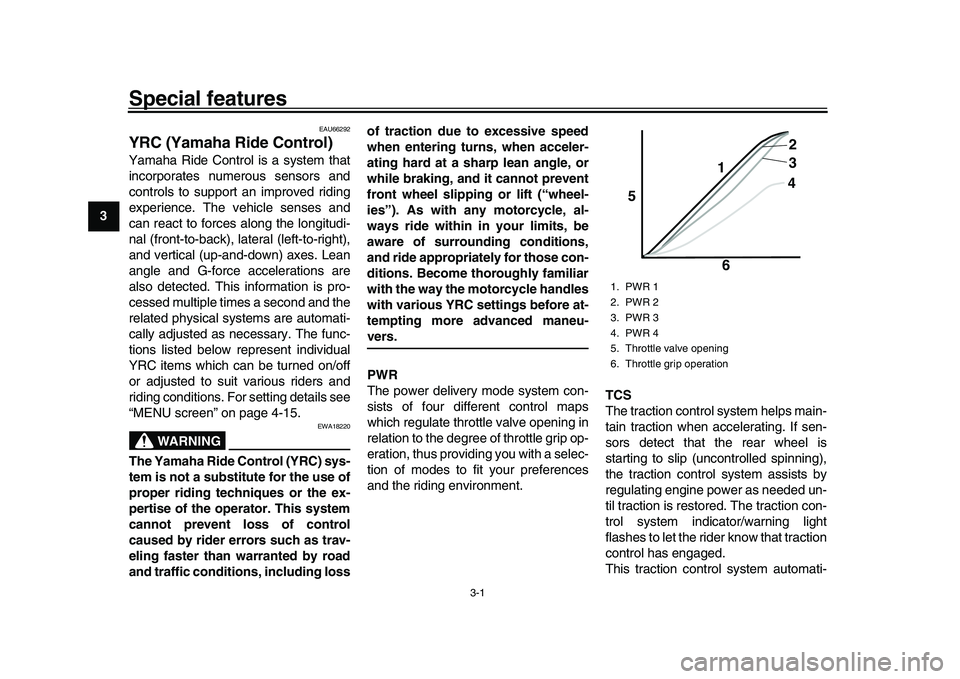
3-1
1
23
4
5
6
7
8
9
10
11
12
Special features
EAU66292
YRC (Yamaha Ride Control)Yamaha Ride Control is a system that
incorporates numerous sensors and
controls to support an improved riding
experience. The vehicle senses and
can react to forces along the longitudi-
nal (front-to-back), lateral (left-to-right),
and vertical (up-and-down) axes. Lean
angle and G-force accelerations are
also detected. This information is pro-
cessed multiple times a second and the
related physical systems are automati-
cally adjusted as necessary. The func-
tions listed below represent individual
YRC items which can be turned on/off
or adjusted to suit various riders and
riding conditions. For setting details see
“MENU screen” on page 4-15.
WARNING
EWA18220
The Yamaha Ride Control (YRC) sys-
tem is not a substitute for the use of
proper riding techniques or the ex-
pertise of the operator. This system
cannot prevent loss of control
caused by rider errors such as trav-
eling faster than warranted by road
and traffic condition s, including lossof traction due to excessive speed
when entering turns, when acceler-
ating hard at a sharp lean angle, or
while braking, and it cannot prevent
front wheel slipping or lift (“wheel-
ies”). As with any motorcycle, al-
ways ride within in your limits, be
aware of surrounding conditions,
and ride appropriately for those con-
ditions. Become thoroughly familiar
with the way the motorcycle handles
with various YRC settings before at-
tempting more advanced maneu-
vers.
PWR
The power delivery mode system con-
sists of four different control maps
which regulate throttle valve opening in
relation to the degree of throttle grip op-
eration, thus providing you with a selec-
tion of modes to fit your preferences
and the riding environment.
TCS
The traction control system helps main-
tain traction when accelerating. If sen-
sors detect that the rear wheel is
starting to slip (uncontrolled spinning),
the traction control system assists by
regulating engine power as needed un-
til traction is restored. The traction con-
trol system indicator/warning light
flashes to let the rider know that traction
control has engaged.
This traction control system automati-
1. PWR 1
2. PWR 2
3. PWR 3
4. PWR 4
5. Throttle valve opening
6. Throttle grip operation
5
64
3 2
1
BX4-9-E0.book 1 ページ 2016年12月1日 木曜日 午後8時7分
Page 19 of 130
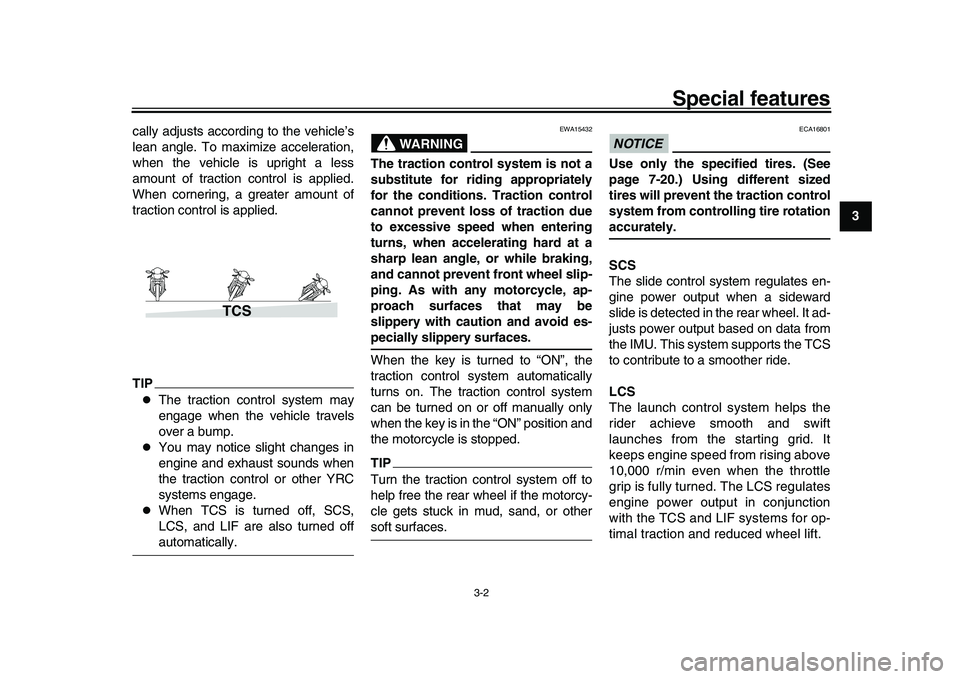
Special features
3-2
1
234
5
6
7
8
9
10
11
12
cally adjusts accordin
g to the vehicle’s
lean angle. To maximize acceleration,
when the vehicle is upright a less
amount of traction control is applied.
When cornering, a greater amount of
traction control is applied.
TIP
The traction control system may
engage when the vehicle travels
over a bump.
You may notice slight changes in
engine and exhaust sounds when
the traction control or other YRC
systems engage.
When TCS is turned off, SCS,
LCS, and LIF are also turned offautomatically.
WARNING
EWA15432
The traction control system is not a
substitute for riding appropriately
for the conditions. Traction control
cannot prevent loss of traction due
to excessive speed when entering
turns, when accelerating hard at a
sharp lean angle, or while braking,
and cannot prevent front wheel slip-
ping. As with any motorcycle, ap-
proach surfaces that may be
slippery with caution and avoid es-pecially slippery surfaces.
When the key is turned to “ON”, the
traction control system automatically
turns on. The traction control system
can be turned on or off manually only
when the key is in the “ON” position and
the motorcycle is stopped.TIPTurn the traction control system off to
help free the rear wheel if the motorcy-
cle gets stuck in mud, sand, or othersoft surfaces.
NOTICE
ECA16801
Use only the specified tires. (See
page 7-20.) Using different sized
tires will prevent the traction control
system from controlling tire rotationaccurately.
SCS
The slide control system regulates en-
gine power output when a sideward
slide is detected in the rear wheel. It ad-
justs power output based on data from
the IMU. This system supports the TCS
to contribute to a smoother ride.
LCS
The launch control system helps the
rider achieve smooth and swift
launches from the starting grid. It
keeps engine speed from rising above
10,000 r/min even when the throttle
grip is fully turned. The LCS regulates
engine power output in conjunction
with the TCS and LIF systems for op-
timal traction and reduced wheel lift.
TCS
BX4-9-E0.book 2 ページ 2016年12月1日 木曜日 午後8時7分
Page 20 of 130
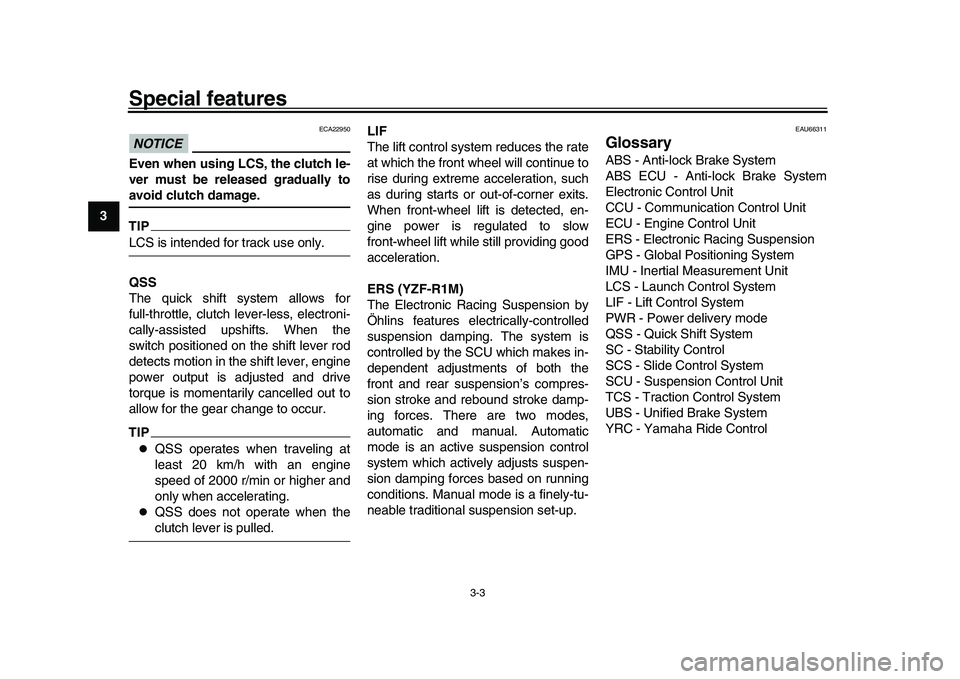
Special features
3-3
1
23
4
5
6
7
8
9
10
11
12
NOTICE
ECA22950
Even when using LCS, the clutch le-
ver must be released gradually toavoid clutch damage.TIPLCS is intended for track use only.
QSS
The quick shift system allows for
full-throttle, clutch lever-less, electroni-
cally-assisted upshifts. When the
switch positioned on the shift lever rod
detects motion in the shift lever, engine
power output is adjusted and drive
torque is momentarily cancelled out to
allow for the gear change to occur.TIP
QSS operates when traveling at
least 20 km/h with an engine
speed of 2000 r/min or higher and
only when accelerating.
QSS does not operate when theclutch lever is pulled. LIF
The lift control system reduces the rate
at which the front wheel will continue to
rise during extreme acceleration, such
as during starts or out-of-corner exits.
When front-wheel lift is detected, en-
gine power is regulated to slow
front-wheel lift while still providing good
acceleration.
ERS (YZF-R1M)
The Electronic Racing Suspension by
Öhlins features electrically-controlled
suspension damping. The system is
controlled by the SCU which makes in-
dependent adjustments of both the
front and rear suspension’s compres-
sion stroke and rebound stroke damp-
ing forces. There are two modes,
automatic and manual. Automatic
mode is an active suspension control
system which actively adjusts suspen-
sion damping forces based on running
conditions. Manual mode is a finely-tu-
neable traditional suspension set-up.
EAU66311
GlossaryABS - Anti-lock Brake System
ABS ECU - Anti-lock Brake System
Electronic Control Unit
CCU - Communication Control Unit
ECU - Engine Control Unit
ERS - Electronic Racing Suspension
GPS - Global Positioning System
IMU - Inertial Measurement Unit
LCS - Launch Control System
LIF - Lift Control System
PWR - Power delivery mode
QSS - Quick Shift System
SC - Stability Control
SCS - Slide Control System
SCU - Suspension Control Unit
TCS - Traction Control System
UBS - Unified Brake System
YRC - Yamaha Ride Control
BX4-9-E0.book 3 ページ 2016年12月1日 木曜日 午後8時7分